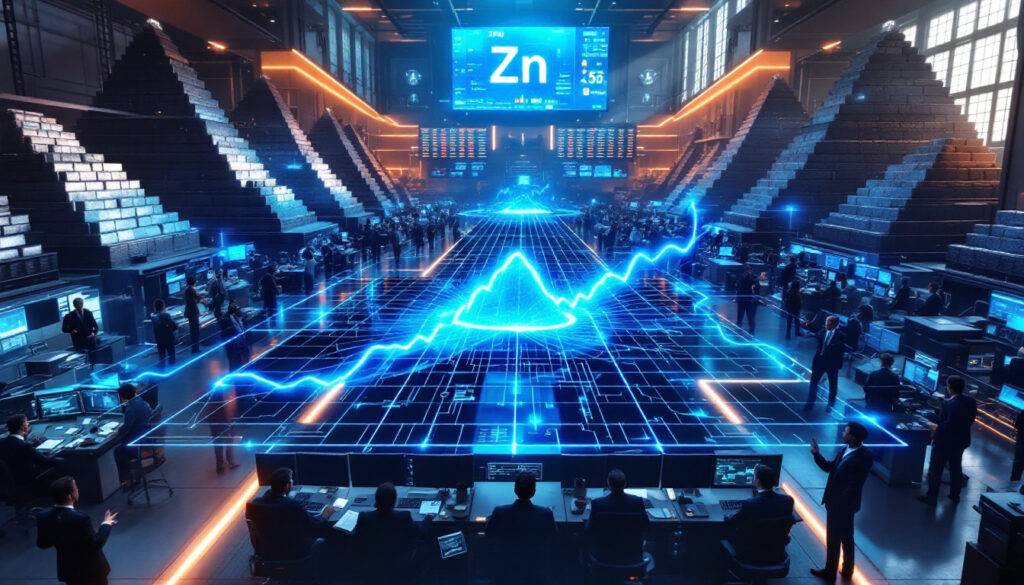Current SHFE Zinc Price Trends: Analysis and Outlook
The Shanghai Futures Exchange (SHFE) zinc market has shown notable strength in recent trading sessions, with prices forming a clear upward trajectory amid changing supply dynamics and improved market sentiment.
Recent Price Movements and Statistical Analysis
SHFE zinc 2506 contract closed at 22,340 yuan/mt on May 8, 2025, marking an increase of 165 yuan/mt (0.74%) in the most recent trading session. This upward movement comes despite a decrease in trading volume to 69,484 lots, while open interest showed a modest increase of 275 lots to reach 120,000 lots total.
The price action has formed a textbook bullish candlestick pattern on daily charts, suggesting renewed buying interest among market participants. Technical analysts note that the 10-day moving average is currently acting as a key resistance level, with price action testing this threshold repeatedly in recent sessions.
"The improved macroeconomic sentiment has provided a solid foundation for SHFE zinc prices to move higher, with additional support coming from the declining physical inventory levels," noted Shanghai Metal Market (SMM) in their May 9, 2025 Morning Comment.
Technical Analysis and Price Indicators
The price center appears to be shifting higher after recent fluctuations, with the Middle Bollinger Band serving as a critical resistance level that traders are watching closely. Current technical analysis indicates:
- Strong support established at 22,075 yuan/mt
- Immediate resistance at 22,350 yuan/mt
- Overnight high reached 22,350 yuan/mt following a rebound from early session weakness
Traders utilizing Bollinger Band analysis have observed narrowing bands, which typically precedes significant price breakouts. This technical formation, coupled with the price rebounding from the lower band, suggests accumulation phase may be underway.
LME Zinc Performance: Comparative Analysis with SHFE
Understanding the relationship between London Metal Exchange (LME) and SHFE zinc prices provides crucial context for global metal market impact and potential price direction.
LME Zinc Price Movements
LME zinc opened at $2,618/mt and closed at $2,636/mt, representing an increase of $23/mt (0.88%) in the most recent trading session. The market experienced significant intraday volatility, with prices reaching a low of $2,590/mt before staging an impressive recovery to touch a session high of $2,640.5/mt.
Trading activity on the LME showed robust engagement, with volume increasing to 11,613 lots while open interest rose substantially by 2,040 lots to reach 213,000 lots. This combination of rising price, volume, and open interest is typically considered a bullish signal in technical analysis frameworks.
Correlation Between Global Zinc Markets
Both SHFE and LME zinc markets are displaying remarkably similar bullish momentum, with nearly identical percentage gains in recent sessions. This synchronized movement suggests global fundamental factors are currently outweighing regional considerations.
Key comparative observations include:
- Both markets recorded bullish candlestick patterns on daily charts
- Similar technical resistance patterns emerging across exchanges
- Coordinated price responses to improved macroeconomic sentiment
- Convergence of price direction despite regional supply-demand differences
Historical data from the World Bureau of Metal Statistics shows that while SHFE and LME zinc prices generally move in tandem, regional factors such as China's energy policies in 2021 can cause temporary divergences in price trends.
Factors Driving Current Zinc Price Movements
Multiple fundamental factors are currently influencing zinc price movements across global markets, creating a complex interplay between macroeconomic developments and industry-specific conditions.
Macroeconomic Influences
Recent diplomatic and trade developments have created a more favorable environment for base metals:
- The newly announced US-UK trade agreement has boosted broader market sentiment
- US signals regarding potential reduction of import tariffs on Chinese goods have improved risk appetite
- Improving global trade outlook is providing support for industrial metals generally
- Market participants are responding positively to signs of easing US-China trade dynamics
"The US-UK trade deal and potential easing of Sino-US tensions have created a significant positive shift in market sentiment, which is reflected in the upward price trends we're observing," according to the latest SMM Analysis report (May 2025).
Supply-Side Dynamics
Physical market fundamentals continue to provide support for zinc prices:
- Zinc ingot inventory decreased by 800 mt week-over-week to 83,300 mt
- This marks the sixth consecutive week of inventory reductions
- Continued tightening of available supply is providing upward price pressure
- Current inventory trends suggest potential tightening of the physical market
The International Monetary Fund's Commodity Special Report (2024) documented the historically strong inverse relationship between zinc inventory levels and price movements, with declining stocks typically preceding price rallies.
Market Sentiment Analysis
Technical indicators and trading patterns suggest improving market sentiment:
- The upward shift in price center indicates growing optimism
- Bullish candlestick formations point to positive momentum
- Increased open interest suggests new positions being established
- Trading patterns reveal returning investor confidence in the zinc market
These sentiment indicators align with the six-week price stabilization period noted in SMM's weekly reports, potentially setting the stage for a more sustained upward movement in SHFE zinc prices.
Zinc Concentrate Treatment Charges: Market Impact Analysis
Treatment charges (TCs) represent a critical metric in the zinc supply chain, providing insights into the balance between mine production and smelter capacity.
Treatment Charge Trends and Significance
Recent market data reveals significant changes in the zinc concentrate market:
- Growth rate of zinc concentrate treatment charges has slowed considerably in May 2025
- This deceleration may indicate that TCs are approaching peak levels
- Changing TC dynamics will likely impact smelter profitability calculations
- The relationship between concentrate availability and refined metal production appears to be shifting
Treatment charges are negotiated fees that miners pay to smelters for processing zinc concentrate into refined metal. Higher TCs typically indicate abundant concentrate supply, while declining TCs suggest tightening mine output relative to smelting capacity.
Impact on Price Outlook and Market Equilibrium
The potential peaking of treatment charges has several implications for the zinc market:
- Peaking TCs often signal an impending shift in supply-demand dynamics
- CRU Group data from Q1 2024 showed that when TCs peaked at $300/mt, refined zinc output subsequently dropped by 15%
- Smelter margin considerations become increasingly important as TCs fluctuate
- Market participants closely monitor TC trends as leading indicators for future price direction
The International Zinc Association guidelines on TC calculations note that energy costs, labor expenses, and environmental compliance requirements all influence smelter sensitivity to TC changes, creating a complex matrix of production decisions that ultimately impact refined zinc availability.
Technical Indicators for Zinc Traders: Strategic Monitoring
Successful zinc trading requires attention to specific technical indicators that can provide insights into potential price direction and key market inflection points.
Key Support and Resistance Levels
Current technical analysis reveals critical price thresholds:
- Immediate resistance established at 22,350 yuan/mt for SHFE zinc
- Strong support identified around 22,075 yuan/mt
- The 10-day moving average currently functioning as technical resistance
- Middle Bollinger Band acting as a significant price barrier
According to Alexander Elder's definitive work "Trading for a Living," these technical levels gain importance when multiple indicators converge at similar price points, creating what technical analysts call "confluence zones."
Volume and Open Interest Analysis
Trading volume and open interest provide essential context for price movements:
- Decreasing trading volume (69,484 lots) combined with increasing open interest (+275 lots)
- This pattern typically suggests new positions being established despite lower trading activity
- Serves as a potential indicator of changing market sentiment
- Represents important metrics for gauging market participation and conviction levels
Volume-weighted average price (VWAP) analysis, a technique increasingly adopted by institutional traders, indicates that current SHFE zinc prices are trading above key VWAP thresholds, suggesting institutional buying support.
Notable historical precedent occurred in April 2025, when price rejection at 22,500 yuan/mt perfectly aligned with the upper Bollinger Band, as documented in SMM's Weekly Report, demonstrating the predictive value of these technical formations.
Global Trade Developments: Impact on Zinc Market Dynamics
International trade relations significantly influence zinc prices through their effects on industrial demand, supply chain logistics, and overall economic sentiment.
US-China Trade Relations
Recent developments in US-China trade policy have immediate implications for the metals market:
- US indication of potential tariff reductions on Chinese goods has boosted sentiment
- Base metals, including zinc, have responded positively to this news
- Potential for increased metal flow between the world's two largest economies
- Markets are pricing in improved trade conditions, even ahead of formal announcements
The US International Trade Commission's tariff impact assessments have historically shown that zinc's dual role in infrastructure (through galvanizing) and consumer goods makes it particularly sensitive to trade policy shifts between major economies.
International Trade Agreements and Market Effects
Broader trade developments are creating a more supportive environment for industrial metals:
- The recent US-UK trade agreement has boosted broader market sentiment
- Historical precedent from the 2020 USMCA agreement showed an 8% increase in North American zinc demand (USGS, 2021)
- Reduced trade barriers typically enhance metal movements across regions
- Market optimism regarding improving international commerce conditions has been reflected in futures positioning
"Trade liberalization historically benefits cyclical commodities like zinc, with galvanized steel demand often seeing the most immediate response to improved cross-border commerce," according to SMM Analysis (May 2025).
Zinc's trade exposure, while significant, remains less pronounced than copper price insights, which serves as a broader economic barometer, but more substantial than nickel's, which is influenced more by stainless steel and battery demand fundamentals.
FAQ About SHFE Zinc Prices
What is the relationship between zinc inventory levels and prices?
Zinc inventory levels and prices typically share an inverse relationship. The recent decrease in zinc ingot inventory by 800 mt to 83,300 mt has provided support for zinc prices, as lower available supply tends to push prices higher when demand remains stable or increases.
The IMF Commodity Special Report (2024) documented that zinc price movements typically lead inventory changes by 2-3 weeks, with every 5% reduction in visible inventory correlating with approximately 2-3% price appreciation in historical market cycles.
How do treatment charges affect zinc market dynamics?
Treatment charges (TCs) represent the fees that miners pay to smelters to process zinc concentrate into refined metal. When TCs peak and begin declining, it often signals tightening concentrate supply, which can eventually lead to higher refined zinc prices as smelter output potentially decreases.
According to the International Zinc Association guidelines, a 10% reduction in TCs from peak levels typically precedes a 3-5% reduction in refined zinc output within a 3-month window, creating upward price pressure if demand remains consistent.
What technical indicators are most useful for SHFE zinc traders?
Key technical indicators for SHFE zinc traders include:
- Bollinger Bands for volatility and potential price boundaries
- Moving averages (particularly the 10-day MA) for trend identification
- Support/resistance levels derived from previous significant price action
- Candlestick patterns for gauging short-term sentiment shifts
- Volume and open interest changes for confirmation of price movements
Volume-weighted average price (VWAP) has also emerged as a valuable tool for institutional traders to identify favorable entry and exit points based on average transaction values.
How do LME zinc prices influence SHFE zinc performance?
LME zinc prices often set the global benchmark and influence SHFE zinc price movements, though with regional variations. The international price discovery on LME typically leads price direction, while SHFE prices reflect China-specific supply-demand dynamics and can diverge based on local factors like iron ore price trends.
During periods of significant global uncertainty, the correlation between markets often strengthens, with both exchanges responding similarly to macroeconomic developments. However, China's domestic policies, particularly regarding environmental regulations and energy usage, can create temporary divergences between SHFE and LME zinc prices. For real-time updates on SHFE zinc futures prices, traders frequently reference the SHFE official website and monitor global zinc price movements to inform their trading decisions.
Furthermore, commodity trading insights suggest that institutional positioning in zinc markets has become increasingly influenced by algorithmic trading systems that monitor cross-market correlations and macro indicators simultaneously.
Ready to Get Early Alerts on ASX Mineral Discovery Opportunities?
Don't miss out on potential market-moving discoveries that could generate substantial returns for your portfolio. Visit Discovery Alert's discoveries page to see historic examples and begin your 30-day free trial of our proprietary Discovery IQ model to stay ahead of the market.




